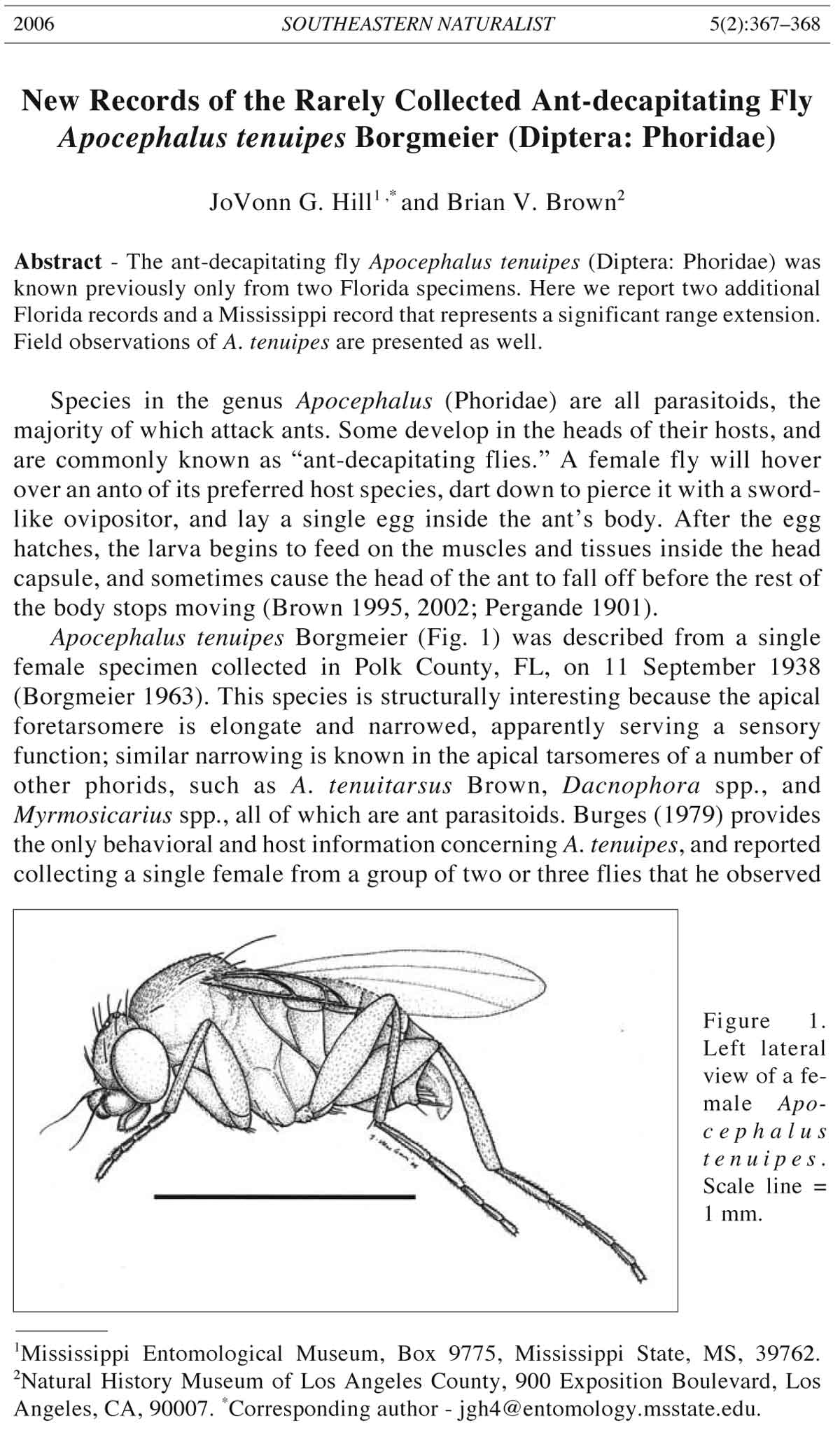2006 SOUTHEASTERN NATURALIST 5(2):367–368
New Records of the Rarely Collected Ant-decapitating Fly
Apocephalus tenuipes Borgmeier (Diptera: Phoridae)
JoVonn G. Hill1 ,* and Brian V. Brown2
Abstract - The ant-decapitating fly Apocephalus tenuipes (Diptera: Phoridae) was
known previously only from two Florida specimens. Here we report two additional
Florida records and a Mississippi record that represents a significant range extension.
Field observations of A. tenuipes are presented as well.
Species in the genus Apocephalus (Phoridae) are all parasitoids, the
majority of which attack ants. Some develop in the heads of their hosts, and
are commonly known as “ant-decapitating flies.” A female fly will hover
over an anto of its preferred host species, dart down to pierce it with a swordlike
ovipositor, and lay a single egg inside the ant’s body. After the egg
hatches, the larva begins to feed on the muscles and tissues inside the head
capsule, and sometimes cause the head of the ant to fall off before the rest of
the body stops moving (Brown 1995, 2002; Pergande 1901).
Apocephalus tenuipes Borgmeier (Fig. 1) was described from a single
female specimen collected in Polk County, FL, on 11 September 1938
(Borgmeier 1963). This species is structurally interesting because the apical
foretarsomere is elongate and narrowed, apparently serving a sensory
function; similar narrowing is known in the apical tarsomeres of a number of
other phorids, such as A. tenuitarsus Brown, Dacnophora spp., and
Myrmosicarius spp., all of which are ant parasitoids. Burges (1979) provides
the only behavioral and host information concerning A. tenuipes, and reported
collecting a single female from a group of two or three flies that he observed
1Mississippi Entomological Museum, Box 9775, Mississippi State, MS, 39762.
2Natural History Museum of Los Angeles County, 900 Exposition Boulevard, Los
Angeles, CA, 90007. *Corresponding author - jgh4@entomology.msstate.edu.
Figure 1.
Left lateral
view of a female
Apoc
e p h a l u s
t e n u i p e s .
Scale line =
1 mm.
368 Southeastern Naturalist Vol. 5, No. 2
hovering above and landing on minor workers of the ant, Pheidole dentata
Mayr, in Palm Beach County, FL, on 26 September 1978.
Here we report three additional records of A. tenuipes, two from Florida
and one from Mississippi, the latter record representing a significant range
extension. Two of the records confirm the host record of P. dentata. Additional
information on the behavior of A. tenuipes is given as well. Voucher
specimens have been deposited in the Natural History Museum of Los
Angeles County and the Mississippi Entomological Museum.
New Records
Florida
Highlands County. Lake Placid, Archbold Biological Station, 14–16
April 1989, B. Brown, D. Feener; attacking Pheidole dentata workers on
tuna baits. (3 females).
Putnam County. Hollister, 26 April 1985, E.G. Milstrey; emerged from
puparium in gopher tortoise burrow (1 female).
Mississippi
Oktibbeha County. Osborn, 33°30'21"N 88°44'09"W, 24 July 2003, J.G.
Hill; attacking Pheidole dentata majors in Black Belt Prairie (2 females).
At approximately 9:00 a.m. on 24 July 2003 a Pheidole dentata colony in
a Black Belt prairie remnant in Mississippi was excavated in order to collect
major workers. As the workers were being collected, several flies were
noticed hovering approximately 4–6 cm above the mass of ants. The flies
would dart down and quickly touch the heads of the Pheidole majors in an
apparent attempt to oviposit. No attempts by the flies to oviposit on the
Pheidole minors were observed. Two of the flies were collected with an
aspirator as they hovered above the colony.
Acknowledgments
Thanks to Richard Brown, Terry Schiefer, and Clarence Collison for their comments
on this manuscript, and to Joe MacGown for providing the illustration of A.
tenuipes and comments on the manuscript. This research was supported by the USDAARS
Area-Wide Management of Imported Fire Ant Project.
Literature Cited
Borgmeier, T. 1963. Revision of the North American phorid flies. Part 1. The
Phorinae, Aenigmatiinae, and Metopininae, except Megaselia (Diptera,
Phoridae). Studia Entomologica 6:1–256.
Brown, B.V. 1995. Ant-decapitating flies: Nature’s executioners. Terra Magazine
32(1–2):4.
Brown, B.V. 2002. Revision of the Apocephalus pergandei-group of ant-decapitating
flies (Diptera: Phoridae). Contributions in Science No. 496. 58 pp.
Burges, R.J. 1979. A rare fly and its parasitic behavior toward an ant (Diptera:
Phoridae; Hymenoptera: Formicidae ). Florida Entomologist 62(4):413–414.
Pergande, T. 1901. The ant-decapitating fly. Proceedings of the Entomological
Society of Washington 4:497–502.













 The Southeastern Naturalist is a peer-reviewed journal that covers all aspects of natural history within the southeastern United States. We welcome research articles, summary review papers, and observational notes.
The Southeastern Naturalist is a peer-reviewed journal that covers all aspects of natural history within the southeastern United States. We welcome research articles, summary review papers, and observational notes.